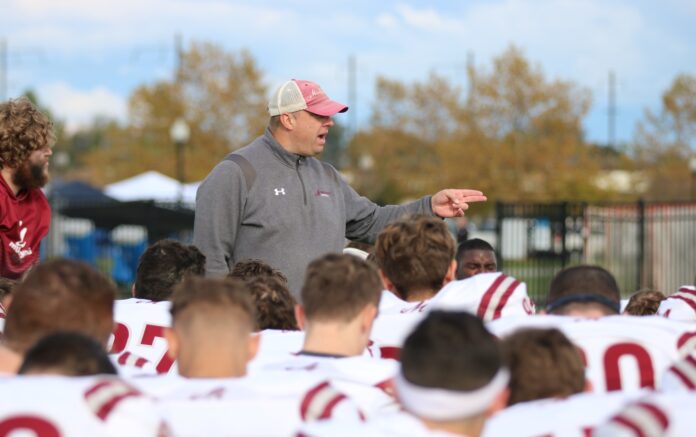The student-athlete is a mystical creature, with unknown origins and fantastical creations.
Nope.
The recruitment process is exact and considers the whole student, not just his or her athletic ability.
What makes a Mule? What puts them on Football Head Coach Nate Milne’s and Volleyball Head Coach Rob McVicker’s radars?
For volleyball, McVicker has to fill out the positions of pin hitter, setter and libero. When recruiting he said, “The biggest thing we look for is versatility.” While volleyball is a non-contact sport, injuries from wear and tear as well as concussions stretch a fifteen-person roster.
McVicker explains that, “I don’t want a middle that just [plays] the middle, because that’s going to limit their ability to get on the court, whether they’re the fourth middle on a team or they’re a middle, but they can also play some right side, they can also be strong enough [to play] back row, where you don’t have to take them out.”
Versatility is a sign of a player’s athleticism in volleyball as well as football. At Muhlenberg it is not atypical for a player to move from offense to defense. During film analysis, Trey Brown, linebacker and QB coach for the Mules, says, “Depending on the position there are certain metrics in place that we’re shooting for. Obviously the linemen you want a certain size, you want them to be physical on tape, good height, good weight, bend well, you know little things like that. You’re always looking [for] playmakers out on the edge.”
With a trained eye, Brown and Kory David, defensive coach, can comb film from Hudl–a platform mostly used by high school athletes to promote their game film to potential college coaches. Sometimes a player may not be working in the same offensive scheme as Muhlenberg runs, so the film might not show the kick-slide Brown might look for. Analyzing film requires “vision” according to him.
Outside of film analysis, volleyball and football differ greatly in how players are evaluated in person. Volleyball is an extremely club dominated sport. Outside of their high school seasons, volleyball recruits are on club teams from November to June. McVicker spends his offseason “coaching a 16th team [16-year-old age group] right now. So we have 10 tournaments and [with] those 10 tournaments, I’ll have the ability when I’m not coaching to be able to recruit, which is a really big benefit.”
For football, when David, “gets young men here on campus going into their senior year, and get[s] a chance to evaluate them, it’s those little things because it gets some contact. How you bend, how do you move, you know, maybe it’s 90 degrees out? Are they tough enough to persevere for that 30-minute period, just the little things, you [are] just trying to gauge from them.” Perseverance is certainly key to the football program’s success during the Milne dynasty.
At the end of the day, film evaluation, tournament scouting and clinics are meaningless unless the recruit fits and loves the school. When recruiting, McVicker asks himself, “Will they fit here? And if volleyball was taken away from them for any reason would they still be happy here?”
For both football and volleyball, the most important word is “fit.” When looking at recruits, “First and foremost is a recommendation from their high school coach, that’s going to tell us about their character. More than anything we want to make sure that they’re going to fit in at Muhlenberg College. Then we dive into their academics. That’s going to really be step two, because Muhlenberg is an elite academic experience,” says Milne.
At the end of the day your max bench is not enough to get you on the Muhlenberg back-to-back championship team. That won’t even get you on a short list. You must fit with the team and school culture.
McVicker, who recently wrapped his first year as head coach, described his experience as an assistant coach for the Muhlenberg volleyball when, “We were in a spot where we really needed to fill our roster, and we weren’t being as strict with whether this player is strong enough. If this player[s] there or this player[s] here, as far as athletic guidelines, we just kind of needed numbers. There was this player that just did not fit well with the team. She did her overnight, and we talked to the team after—like we do with most recruits, and they said we don’t think she’d be a good fit. And we pulled our offer.” Putting team chemistry first ended “up filling that spot with one of our captains right now.”
While athletics may be a large part of a student’s life at Muhlenberg, their happiness will be determined by how involved they are on campus—recruits know this. David looks in recruits’ and their parents’ eyes and sees that they make the decision when Muhlenberg students are, “sitting there laughing, joking, talking, you know, studying together.” Milne highlights that, “Muhlenberg students have an impact on recruiting, whether you like athletics or not. We’re selling the entire campus. And so I think that is a huge part of this as well. We talk about the theatre program, we talk about the certain academics on our campus, we’ve talked about locations and clubs, sports and other activities”
Those captured moments, when frisbees are thrown on the quad, a comedy show, a chemistry workshop before the big exam, these are the moments that will fill a recruits four years on campus.






















